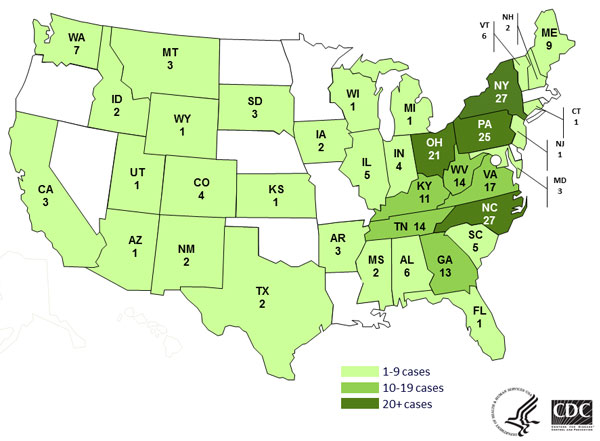Pertussis cases in California top 4,500
California has logged 1,100 new cases of pertussis (whooping cough) in the past 2 weeks, bringing its season total to 4,558, almost twice as many as in all of 2013, the California Department of Public Health (CDPH) said today in a news release.
Another infant has died of the disease, bringing the state death toll to three. Children 4 months old or younger have accounted for almost two thirds of pertussis hospitalizations to date, the CDPH said.
"Infants are at the greatest risk of illness and death from pertussis," said Ron Chapman, MD, MPH, CDPH director. "Vaccination is the best form of protection. We're encouraging all parents to vaccinate their children, and for pregnant women to be vaccinated to protect their babies." He also encouraged anyone caring for infants to receive the tetanus, diphtheria, and pertussis (Tdap) vaccine.
Last year California logged 2,532 pertussis cases, according to the release. CDPH data showed 1,023 cases in 2012 and 3,103 in 2011, with no deaths in any of those 3 years. In 2010, however, the state reported 9,163 cases, 10 of which were fatal.
Jun 27 CDPH news release
Recent CDPH pertussis reports
Live-poultry Salmonella outbreak grows to 251 cases in 37 states
A Salmonella outbreak linked to live poultry from a mail-order hatchery in Ohio has doubled in the past month, to 251 cases in 37 states, the Centers for Disease Control and Prevention (CDC) said today. The numbers represent 125 new cases and 11 newly affected states since the CDC's previous update on May 30.
The patients range in age from less than 1 year to 95, with a median age of 28 years, the CDC said. Thirty-nine percent of case-patients are 10 years old or younger. Of 171 case-patients with available information, 54 (32%) have been hospitalized.
Eighty percent of patients interviewed reported contact with live poultry such as chicks and ducklings before becoming ill. Illness-onset dates ranged from Feb 4 to Jun 4. The outbreak involves three Salmonella strains, which is up one from the previous update: Infantis, Newport, and Hadar.
"Findings of multiple traceback investigations of live baby poultry from homes of ill persons have identified Mt. Healthy Hatcheries in Ohio as the source of chicks and ducklings," the CDC said. "This is the same mail-order hatchery that has been associated with multiple outbreaks of human Salmonella infections linked to live poultry in the past, including in 2012 and 2013."
States with the most cases are New York and North Carolina, both with 27; Pennsylvania, with 26; and Ohio, with 21. (See CDC map below.)
Jun 27 CDC update
May 30 CIDRAP News scan on previous update

Meta-analysis: Norovirus causes 18% of global gastroenteritis
Norovirus causes almost a fifth of all cases of gastroenteritis (GE) worldwide, according to a meta-analysis published today in The Lancet Infectious Diseases.
CDC and Dutch researchers searched health-related databases for studies published from 2008 on. They included in their review 175 articles that covered 187,336 GE patients.
The pooled prevalence of norovirus was 18%, with a 24% prevalence in cases of acute GE in the community and a 20% prevalence in outpatient settings. Conversely, the prevalence was 17% in inpatient settings.
Patient age and whether the study included years in which novel strains emerged were not associated with norovirus prevalence, the authors noted. They conclude, "Targeted intervention to reduce norovirus burden, such as vaccines, should be considered."
Jun 27 Lancet Infect Dis study
Jun 27 Lancet Infect Dis related commentary
Campylobacter tops list of UK foodborne disease culprits
A nationwide UK study found that Campylobacter is the most common cause of foodborne disease outbreaks, and poultry is the most common culprit, according to results published yesterday by the nation's Food Standards Agency (FSA).
Researchers used the results of the second study of infectious intestinal disease (IID2) combined with other sources, such as data from a literature review, to estimate the impact of foodborne disease in 2009, the year IID2 was conducted. The team tested for 13 common pathogens and estimated that Britain sees more than 500,000 foodborne illnesses a year.
They found that Campylobacter sickens an estimated 280,000 people a year and results in 39,000 primary care visits. Other common foodborne pathogens were Clostridium perfringens (an estimated 80,000 cases), norovirus (74,000), and Salmonella (33,000). Salmonella, however, caused the most hospitalizations—about 2,500.
The investigators determined that poultry was associated with 244,000 cases. Next highest was produce, which included leafy greens, other vegetables, fruits, nuts, and seeds (an estimated 48,000 cases); followed by beef and lamb (43,000); seafood (32,000); and eggs (26,000).
Jun 26 FSA study












